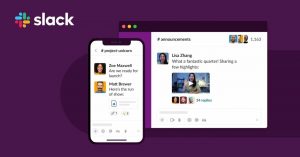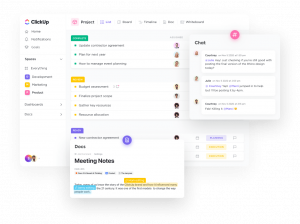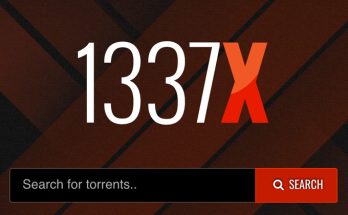When considering project management software, the names Slack and ClickUp frequently come up. Both programs might help you with task management and process automation. However, it has features that differentiate it from ClickUp, and I’ll go over what makes each software unique. This article will discuss each software’s distinguishing characteristics like ClickUp vs Slack, most compelling use case, similarities, and differences. My goal is to help you better understand each program so that you can pick the best for you and your business.
What is Slack?
Slack is a collaborative hub that debuted in 2013. It promises to bring simplicity and productivity to the workplace.
How it Works:
The solution consolidates people, tools, and information under one roof to propel the business ahead. Slack may accept any device and serve you without discrimination. You can access it from a computer or mobile device. You have many options.
Slack is an excellent tool for team communication. It allows you to send direct, group, and Slack channels, among other things. Slack may also be integrated with significant devices such as HubSpot, Zoom, Google Drive, and ClickUp!
Slack functions
What drives Slack? Stay with us:
1. well-organized Channels
“There is nothing unfair than having too many channels.” That is Slack speaking.
All interactions take place in Slack’s channels. You can use the app to build private and public channels depending on office locations, projects, subjects, etc. Most importantly, Slack channels aid in the organization and clarity of work. Start or join a channel for any topic to focus on the conversations and work that are most important to you.
If you require more extensive functionality, the premium edition permits each channel to have its email address. So say goodbye to clogged inboxes.
2. Audio and video conferencing
Don’t like putting out a long message to get an answer? Or do you want to fix a problem or brainstorm project ideas with your coworkers in real-time?
Not a problem!
Slack’s one-on-one audio and video calls will come in handy. And the premium subscription is the way to go if you want up to 15 people to join your call and video sessions. Slack also supports interaction with third-party conferencing platforms, allowing you to communicate with your team as quickly as possible.
3. Slack Connectivity
Do you want complete collaboration? Now is the time to retire the tired and segregated email threads. Instead, Slack’s connect feature allows conversations to occur in one location.
It also enables your team to collaborate and operate securely with other partners such as agencies, vendors, clients, and others. As a result, reaction times are faster, and enterprise support is better.
4. Automation
Standard request processes, providing updates, and other routine duties should not consume your productive and creative energies. Instead, Slack’s automation will put you up for success and allow your productivity to skyrocket.
Slack’s workflow builder automates your daily and routine tasks, allowing you to get replies, approvals, and issues resolved faster. It also supports Zapier and other integrations for maximum automation.
Pricing slack
The features are excellent, but is Slack economical? First, let’s look at its pricing options:
Free: The free plan lets you view the most recent 10,000 messages and integrate up to ten third-party apps. It helps with 1:1 audio and video calls, has unlimited channels, permits file sharing, and has 5GB of storage space.
Pro ($6.67/month/person): You get limitless app integration, 10GB of file storage per user, group calls and screen sharing with up to 15 people, searchability, and intelligence with the Pro version. Other features include Google authentication and guest access.
Business+ ($12.50/month/person): The Business Plus package includes complete message history and up to 20GB of storage per crew member. It also guarantees 99.99 percent uptime and 24/7 support.
Enterprise (custom pricing): Want to take things to the next level? The Enterprise plan includes enterprise-grade security and can support up to 500,000 users. You will also receive customizable policies, centralized controls, and personalized assistance.
Best Slack vs. ClickUp applications:
ClickUp vs Slack are both accessible as mobile apps for Android and iOS smartphones, allowing users to work on the go. Most third-party programs and apps are compatible with each product, including HubSpot CRM, Trello, Jira, Asana, Slack, Wrike, Basecamp, Microsoft Teams, Salesforce, and others.
ClickUp vs Slack feature calendar management, allowing you to use the calendar view to monitor your team’s schedule and workload quickly so you can manage human resources more efficiently. ClickUp’s pricing model is perfect for managing small teams and start-ups because of its extended free plan and user-friendly UI. It is best suited for larger companies and industries that rely on a massive volume of work, such as marketing organizations.
ClickUp vs Slack are pitted against one another. To clarify processes and timetables for your team, use unambiguous graphics. Slack is project management software that allows clients to create custom workflows to help with project execution and job operations.
Slack can be used to establish product roadmaps, business plans, marketing campaigns, webinars, and other business duties. The program also allows invoicing and billing, making it ideal for businesses in the commercial sector.
Slack offers a free subscription for up to two users. ClickUp is a project management solution that functions as resource management and team collaboration tool in the cloud. Users of ClickUp can use the platform to design customized workspaces, plan, implement, and evaluate projects, and automate operations. Furthermore, the software has necessary functions in any workplace, such as spreadsheets, reminders, emails, screenshots, and recordings. Users appreciate ClickUp’s customizable dashboards and themes, which make it suited for a wide range of jobs.
- ClickUp offers an unlimited free subscription with a maximum storage space of 100MB.
- Price: $9 per user each month.
- 14-day no-risk trial
A new window is opened Criteria for Slack vs. ClickUp Comparison
How affordable is the price of the tool?
Differences
The two websites are Slack and ClickUp.
ClickUp needs the usage of a third-party video conferencing provider; Slack offers video conferencing, allowing you to connect with team members remotely easily.
ClickUp does not have a sophisticated onboarding tool, unlike Slack does.
Slack provides robust lead generation and management tools, making it ideal for enterprises involved in marketing or sales; ClickUp does not.
Slack users can create private boards that are unsearchable and invisible to company administrators, allowing them to have confidential conversations with other users in a secure setting; ClickUp does not.
Slack’s dashboard is more streamlined and intuitive, but ClickUp’s dashboard may be overwhelming owing to the volume of the information displayed.
ClickUp
ClickUp has you covered everything from conversing with remote employees to assigning tasks and automating workflows.
What’s more, the best part?
ClickUp has powerful tools that will help you organize your projects, people, and resources:
1. Task Administration
ClickUp simplifies task management. Using ClickUp’s recurring tasks, you can get ordinary jobs off your plate. Color-coded task priorities assist your team in tackling the most critical chores in the morning. Take advantage of ClickUp Reminders to stay on track.
Slack is only accessible for two people but offers 500MB of storage; ClickUp is a more generous freemium option allowing unlimited users and projects and 100MB of storage.
ClickUp’s most basic ($5/user/month) membership provides unlimited integrations, storage, and dashboards, making it a highly competitive offer in the project management app business. ClickUp users have access to over 300 native integrations that can be leveraged to boost productivity, whereas Slack only offers 50.
To increase productivity, ClickUp uses gamification to capitalize on team members’ predisposition for competition and achievement. It is not available in Slack.
ClickUp offers a free account with no expiration date and an unlimited number of guests, making it ideal for a start-up or small business. In contrast, Slack’s free version is only available to individuals.
2. Remarks
Everyone has probably been in this situation: you’ve assigned a task, and suddenly another part of that activity needs the involvement of something or someone. Previously, you could have just created a new job.
However, with ClickUp, you can avoid the communication snarl and extra duties by simply assigning ClickUp comments to individuals who need to evaluate before proceeding to the next stage. It’s simple to communicate anything about an assignment. There are also forums for responding to other people’s comments.
It allows you to keep all communication channels open and structured. ClickUp also enables you to modify comments at any moment, which is helpful for those who type too rapidly.
3. Incorporations
Did you know you can integrate more than 1000 different apps with ClickUp? Indeed, ClickUp supports the most popular apps, including Google Drive, Zoom, Microsoft Teams, and others. In addition, there are also Google Chat + ClickUp and Slack + ClickUp integrations.
Why settle for one powerful work tool when you may have two?
4. View of the Chat
Chat View is another ClickUp function. It allows you to instantly share link materials and updates while consolidating team communication under one roof. To keep your team dragging on action items, add a team player to chats with @mentions and assign comments.
Learn how social marketing specialist Michelle Thames uses ClickUp’s Chat View to organize her business.
5. ClickUp Email
Send and receive emails quickly in ClickUp, build tasks from emails, create automation, attach emails to jobs, and much more. In addition, it improves team communication by allowing for speedier connectivity and more up-to-date communication between teams.
6. Docs
ClickUp Docs makes it simple to produce beautiful Docs, wikis, and other crucial papers from within your team’s workflow. Connect them to workflows to collaborate on ideas with your team or Docs and wikis to share in-depth thoughts. Then you can add them to workflows.
7. Task Requirements
Make the ideal database with relationships. Connect dependencies, tasks, and documents to get to everything you need in one place. You may effortlessly connect any number of jobs to get to the most critical work items quickly.
You can also link clients to specific deals or customers to their orders. When it comes to Task Dependencies, there are numerous possibilities.
8. Automated
You may streamline workflows and save your creative energy by automating everyday operations. ClickUp Automations is ideal for both complex and basic recurring tasks. For example, do you need a mission assigned to a specific team after completing your work?
That is straightforward automation. Want to notify someone when a deadline is missed? Or do you need to adjust the priority when the status of a task changes? Within ClickUp, you can do it all (even creating bespoke automation).
Slack and ClickUp Comparisons
ClickUp and Slack include user-friendly knowledge libraries with FAQs and tutorials to help new users learn about each product’s capabilities and maximize their potential. Both ClickUp and Slack allow users to see who is online and what projects their team members are working on in real-time.
ClickUp and Slack allow you to create custom dashboards to track project progress, timelines, and budgets conveniently. It can facilitate project planning and guarantee that deadlines are reached.
ClickUp and Slack offer Kanban boards and Gantt chart to help users visualize their team’s work output to focus on the project parts that need to be reinforced. File-sharing features similar to Dropbox or Google Drive are available in both ClickUp and Slack, allowing team members to save files and documents that are only viewable to team members.
ClickUp and Slack provide brainstorming capabilities that allow users to discuss ideas with other members. This collaboration tool can also aid in project planning while keeping it department-inclusive. Both ClickUp and Slack provide 24/7 customer care and phone support to ensure that users receive assistance when they require it.
Both ClickUp and Slack have reporting and analytics tools that you may use to generate reports quickly. This tool allows you to filter data as you write your report, ensuring that only relevant information is included. ClickUp and Slack provide adjustable templates to guarantee that each project is unique and includes all the features necessary for success.
Besides being browser-based, ClickUp and Slack also provide mobile apps that you may use to stay up to date on important topics while on the road. Both pieces of software are available for Android and iOS devices.
Best ClickUp vs Slack Applications
The best is Slack.
Work at Home
Slack features are socially engaging chat platforms and an integrated mailbox for remote communication and teamwork.
Construction
Gantt charts and timelines from Monday.com can provide consumers with a comprehensive overview of any building project.
Marketing
You may use Slack to build complicated, adjustable dashboards that measure the effectiveness of your campaigns.
software development.
Slack offers feature for iteration planning, product roadmaps, and bug tracking.
HR
Using Slack’s table view, you can plan new hire onboarding, professional development, and staff assessments.
CRM and sales
Slack may manage contacts, capture leads, and create custom forms for customer support questions.
Creative
Slack can assist you in getting started on creative projects by providing templates for video products, editorial content, and marketing.





